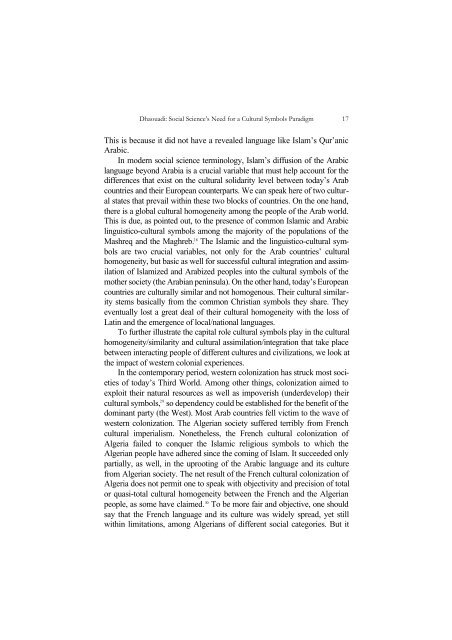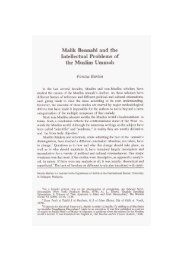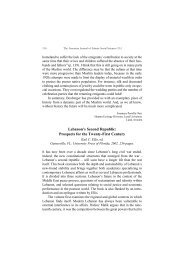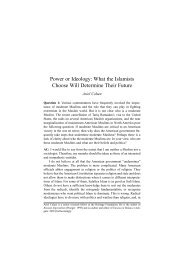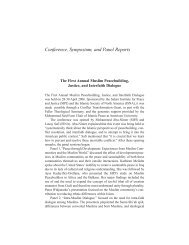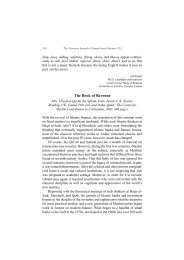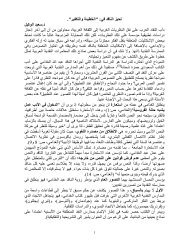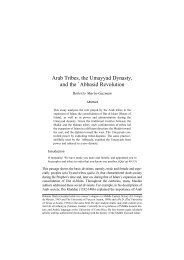Social Science's Need for a Cultural Symbols ... - Epistemology
Social Science's Need for a Cultural Symbols ... - Epistemology
Social Science's Need for a Cultural Symbols ... - Epistemology
Create successful ePaper yourself
Turn your PDF publications into a flip-book with our unique Google optimized e-Paper software.
Dhaouadi: <strong>Social</strong> Science’s <strong>Need</strong> <strong>for</strong> a <strong>Cultural</strong> <strong>Symbols</strong> Paradigm 17<br />
This is because it did not have a revealed language like Islam’s Qur’anic<br />
Arabic.<br />
In modern social science terminology, Islam’s diffusion of the Arabic<br />
language beyond Arabia is a crucial variable that must help account <strong>for</strong> the<br />
differences that exist on the cultural solidarity level between today’s Arab<br />
countries and their European counterparts. We can speak here of two cultural<br />
states that prevail within these two blocks of countries. On the one hand,<br />
there is a global cultural homogeneity among the people of the Arab world.<br />
This is due, as pointed out, to the presence of common Islamic and Arabic<br />
linguistico-cultural symbols among the majority of the populations of the<br />
Mashreq and the Maghreb. 28 The Islamic and the linguistico-cultural symbols<br />
are two crucial variables, not only <strong>for</strong> the Arab countries’ cultural<br />
homogeneity, but basic as well <strong>for</strong> successful cultural integration and assimilation<br />
of Islamized and Arabized peoples into the cultural symbols of the<br />
mother society (the Arabian peninsula). On the other hand, today’s European<br />
countries are culturally similar and not homogenous. Their cultural similarity<br />
stems basically from the common Christian symbols they share. They<br />
eventually lost a great deal of their cultural homogeneity with the loss of<br />
Latin and the emergence of local/national languages.<br />
To further illustrate the capital role cultural symbols play in the cultural<br />
homogeneity/similarity and cultural assimilation/integration that take place<br />
between interacting people of different cultures and civilizations, we look at<br />
the impact of western colonial experiences.<br />
In the contemporary period, western colonization has struck most societies<br />
of today’s Third World. Among other things, colonization aimed to<br />
exploit their natural resources as well as impoverish (underdevelop) their<br />
cultural symbols, 29 so dependency could be established <strong>for</strong> the benefit of the<br />
dominant party (the West). Most Arab countries fell victim to the wave of<br />
western colonization. The Algerian society suffered terribly from French<br />
cultural imperialism. Nonetheless, the French cultural colonization of<br />
Algeria failed to conquer the Islamic religious symbols to which the<br />
Algerian people have adhered since the coming of Islam. It succeeded only<br />
partially, as well, in the uprooting of the Arabic language and its culture<br />
from Algerian society. The net result of the French cultural colonization of<br />
Algeria does not permit one to speak with objectivity and precision of total<br />
or quasi-total cultural homogeneity between the French and the Algerian<br />
people, as some have claimed. 30 To be more fair and objective, one should<br />
say that the French language and its culture was widely spread, yet still<br />
within limitations, among Algerians of different social categories. But it


